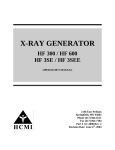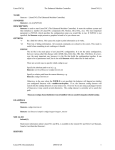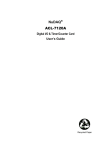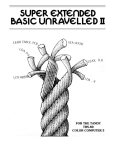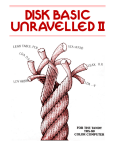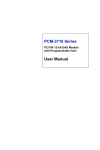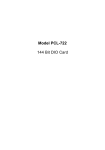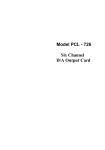Download 112k - Fairchild Engineering Ltd
Transcript
Model PCL-720 Digital I/O & Counter Card PCL-720 Digital I/O and Counter Card USER'S MANUAL This documentation is copyrighted 1990 by Advantech Co., Ltd. All rights are reserved. Advantech Co., Ltd. Reserves the right to make improvements in the products described in this manual at any time without notice. No part of this manual may be reproduced, copied, translated or transmitted, in any form or by any means without the prior written permission of Advantech Co., Ltd. Information provided in this manual is intended to be accurate and reliable. However, Advantech Co., Ltd. assumes no responsibility for its use; nor for any infringements of rights of third parties which may result from its use. PC-LabCard is a trademark of Advantech Co., Ltd. IBM and PC are trademarks of international Business Machines Corporation. MS-DOS is a trade mark of Microsoft Corporation. BASIC is a trademark of Dartmouth College. Intel is a trademark of Intel Corporation. Part No. 2003720000 Rev. C1 Printed in Taiwan Mar. 1990 TABLE OF CONTENTS CHAPTER 1 GENERAL INFORMATION . . . . . . . . . . . . . . . . . . . . . . . 1 1.1. Introduction . . . . . . . . . . . . . . . . . . . . . . . . . . . . . . . . . . . . . . 1 1.2. Features, Application and Specifications . . . . . . . . . . . . . . 1 CHAPTER 2 INSTALLATION . . . . . . . . . . . . . . . . . . . . . . . . . . . . . . . 2.1. Initial Inspection ................................... 2.2. Base Address Selection . . . . . . . . . . . . . . . . . . . . . . . . . . . . . 2.3. Clock Frequency Setting . . . . . . . . . . . . . . . . . . . . . . . . . . . . . 2.4. Installing into the PC . . . . . . . . . . . . . .. . . . . . . . . . . . . . . . . . 5 5 5 7 7 CHAPTER 3 SIGNAL CONNECTION . . . . . . . . . . . . . . . . . . . . . . . 9 3.1. Connector Pin Assignment . . . . . . . . . . . . . . . . . . . . . . . . . . . 9 3.2. Timer/Counter Signal Pads . . . . . . . . . . . . . . . . . . . . . . . . . . 11 3.3. Clock Source Pads . . . . . . . . . . . . . . . . . . . . . . . . . . . . . . . . . . 11 3.4. Strobe of Digital Input . . . . . . . . . . . . . . . . . . . . . . . . . . . . . 12 CHAPTER 4 PROGRAMMING . . . . . . . . . . . . . . . . . . . . . . . . . . . . . . 4.1. Register Structure and Format . . . . . . . . . . . . . . . . . . . . . . . . 4.2. Digital UO Programming . . . . . . . . . . . . . . . . . . . . . . . . . . . . . 4.3. Programmable Interval Timer . . . . . . . . . . . . . . . . . . . . . . . . 4.3.1. The Intel 8253 . . . . . . . . . . . . . . . . . . . . . . . . . . . . . 4.3.2. The Control Byte . . . . . . . . . . . . . . . . . . . . . . . . . . . 4.3.3. Mode Definitions . . . . . . . . . . . . . . . . . . . . . . . . . . 4.3.4. Loading and Reading The Counters . . . . . . . . . . . 13 13 14 15 15 16 17 20 APPENDIX A I/O PORTADDRESS MAP . . . . . . . . . . . . . . . . . . . . . 23 CHAPTER 1 GENERAL INFORMATION 1.1. Introduction The PCL-720 Digital I/O and Counter Card is a PC add-on card that offers you 32 digital input channels , 32 digital output channels and 3 counter/timer channels. All digital input and output channels are TTL/DTL compatible. Each digital input or output channel corresponds to a certain bit of the I/O port of the PC and it is very easy to program the function of this card. To make your application easier, external daughter boards, PCLD-782, PCLD785 and PCLD-786, are designed to work with the digital input/output ports of the PCL-720. The PCLD-782 is a 16-channel opto-isolated digital input board which provides an easy way to input digital data to the PCL-720 when the ground isolation is required The PCLD-785 is a 16-channel relay output board which can be driven by the digital output of the PCL-720 card. The PCLD-786 is an SSR board which can control AC power up to 8 channels. An on-board Intel 8253 programmable interval timer provides three independent 16 bit down counters as timing sources for various applications. Also, a breadboard area is available for customized interface circuits. The PCL-720 (after rev. C) also offers on-board clock sources those are 1 MHz, 100 KHz and 10 KHz and these frequencies can be double, half or quartered by setting jumpers. 1.2 Features, Application and Specifications Features : Ÿ 32 digital input channels Ÿ 32 digital output channels Ÿ High output driving capacity General Information PCL-720 Ÿ Low input loading Ÿ 3-channel programmable interval timer Ÿ On-board crystal based clock source Ÿ Breadboard area for customized circuits Applications Ÿ Industrial ON/OFF control Ÿ Contact closure monitoring Ÿ Switch panel status sense Ÿ BCD interface Ÿ Digital I/O control Ÿ Industrial automation Ÿ Laboratory automation Ÿ Period and pulse width measurement Ÿ Event and frequency counting Specifications Ÿ Dimensions: Ÿ Bus : 9" x 4.125" 22.8 cm x 10.48 cm IBM PC bus Ÿ Slot : One 62-pin slot Ÿ I/O Port Address : Hex 200 - hex 3F8 PCL-720 General Information Ÿ Breadboard Area: 540 (30 X 18) plated-through "donuts" holes, each with a.036' hole on 0.10" centers. Ÿ Digital Input Input Low Level : Input High Level: Input Loading : Input Hysteresis : Ÿ Min. -0.5V, max. 0.8V Min. 2.0V, max. 5.0V Max 0.2 mA at 0.4V Typical 0.4V, min. 0.2V Digital Output Output Low Level : Max. 0.5V at 24 mA (sink) Max. 0.4V at 12 mA Output High Level : Min. 2.0V at 15 mA (source) Min. 2.4V at 3 mA Driving Capacity : 15 TTL's at least CHAPTER 2 INSTALLATION 2.1. Initial Inspection Inside the shipping container, you should find this operating manual and the PCL-720 card. The PCL-720 is carefully inspected both mechanically and electrically before shipment. It should be free of marks and scratches and in perfect electrical order on receipt. Remove the PCL720 interface card from its protective packaging by grasping the metal rear panel. Keep the anti-vibration package since it may be used to return the card if it needs repair. The package may also be used if the card is stored outside of the computer. The board should be handled only by the edges. The integrated circuits on the board can be damaged by static electric discharge. The package 2.2. Base Address Selection Most of the peripheral devices and the interface adapters in the PC are controlled and sensed using the digital input and output pens. These ports are addressed using the I/O port address space of the 8088 or 80286 microcomputer. The I/O port base address for the PCL-720 is selectable by the setting of a DIP switch (SW1). Valid addresses are from hex 200 to hex 3F8. Refer to Figure 2.1 for the location of the DIP switch (SW1). Installation PCL-720 Figure 2.1 The PCL-720 Card The required switch settings for various base addresses are illustrated as below : Note : - ON=0, OFF=1 "X" means "don't care" 1..8 are switch positions A3..A8 correspond to address Lines of the PC bus. A9 is hard-wired to be 1. - * means factory setting PCL-720 Installation --------------------------------------------I/o port Switch position address 1 2 3 4 5 6 (Hex) A8 A7 A6 A5 A4 A3 --------------------------------------------200-207 0 0 0 0 0 0 208-20F 0 0 0 0 0 1 . . * 2A0-2A7 0 1 0 1 0 0 2A8-2AF 0 1 0 1 0 1 . . 2E8-2EF 0 1 1 1 0 1 . 2F8-2FF 0 1 1 1 1 1 3E8-3EF 1 1 1 1 0 1 3F8-3FF 1 1 1 1 1 1 --------------------------------------------- 2.3. Clock Frequency Setting The PCL-720 offers on-board clock sources those are 1 MHz, 100 KHz and 10 KHz when a jumper is placed on the position marked "xl" of JP1. These frequencies can be double, half or quartered by placing a jumper on position "x2", "x1/2" or "xl/4" of the JP1. For example, a frequency source of 25 KHz can be got from the pad marked "100K" when placing the jumper on position "x1/4" of the JP1 as below. oo * oo oo oo JP1 x2 xl x1/2 x1/4 * : Factory setting 2.4. Installing into the PC POWER MUST ALWAYS BE SWITCHED OFF when removing or inserting the PCL-720 card and connecting or disconnecting cables. Use a screw driver to remove the cover mounting screws from the rear of the system unit. Installation PCL-720 Slide the system unit's cover away from the rear and to the front. When the cover will go no further, tilt it up, remove it from the base, and set it aside. The PCL-720 is configured at the factory for the IBM PC, PC/XT, PC/AT and ah IBM PC compatibles. If you need further changes to the configuration please refer to Chapter 2. Installation. Use a screw driver to remove the screw that secures the expansion slot cover. Save the screw for installation of the interface card. The two rear connectors should be pressed through the rear panel first, then press the card carefully into the main board expansion slot. Secure the PCL-720 with the 3/16" mounting screw, then attach and appropriate cable to the connector. Slide the system unit's cover back on. Align the system unit tabs with the cover holes and reinstall the cover mounting screws. CHAPTER 3 SIGNAL CONNECTION 3.1. Connector Pin Assignment The PCL-720 card is equipped with two 20-pin insulation displacement (mass termination) connectors accessible from the rear plate and three other 20-pin insulation displacement connectors on board. All these connectors can be connected to flat cables of the same type. Please refer to Figure 2.1 for the location of each connector. The following diagrams below show their pin assignments. Note : - D/O means digital output - D/I means digital input - GND means ground - CLK is the clock input for the 8253 - GATE is the gate input for the 8253 - OUT is the signal output of the 8253 - STROBE is the external signal to latch the D/I data Connector 1: Signal Connection Connector 2: Connector 3: Connector 4: PCL-720 PCL-720 Signal Connection Connector 5: 3.2. Timer/Counter Signal Pads To make the wiring of the 8253 counter input and output signals easier for user's application, all the “CLK”, “GATE” and “OUT” signals of the three 16 bit counters have their soldering pads. These pads have exactly the same signals as those on connector CN5. For example, if a user wants to use the output of counter 0 (OUT0) as the clock source of counter 1 (CLK1), he (she) can place a wire between the pads marked “OUT0” and “CLK1”. JP2 o CLK0 o GATE0 o OUT0 o CLK1 o GATE1 o OUT1 o CLK2 o GATE2 o OUT2 3.3. Clock Source Pads There are 3 pads offer clock sources of 1MHz, 100KHz and 10KHz when the JP1 is inserted with a jumper at the position 'xl'. These frequencies can be double, half or quartered by placing the jumper on the position 'x2', 'x1/2' or 'x1/4' of the JP1. The user can link one of the clock source to the clock input of the 8253 timer/counter by placing a wire between the corresponding pads. For example, if a user want that the counter 2 has 1 MHz clock input, he(she) can just solder a wire between pads “1M” and “CLK2” and place a jumper on Signal Connection PCL-720 position 'xl' of the JP1. 3.4. Strobe of Digital Input The digital input connectors, CN2 and CN4, have "STROBE" signals at pin-20. The "STROBE" input signals are used to gate the digital input signal DI0 to DI15 and DI16 to DI31. When the "STROBE" input is high or left open, the data which the PC reads from the corresponding input port is the current status of the digital input pins. When the "STROBE" input goes from high to low, the digital input data is latched in the input buffer and the PC reads the data which is the input status on the falling edge of "STROBE". Normally, the "STROBE" pins are left open and the digital input ports have the current status of the digital input pins. If the user wants to read the status of the digital input pins when an certain signal is high, then he (she) can connect the signal to the "STROBE" pins to gate the input data. "STROBE 0" is used to gate the digital input signal on CN2, D/I 0 to D/I 15 and "STROBE 1" is for the input signal on CN4, D/I 16 to D/I 31. Strobe D/I data ------------------------High Transparent Low Latched CHAPTER 4 PROGRAMMING 4.1. Register Structure and Format The most important issue in programming the PCL720 is understanding the meaning of the 8 registers addressable from the selected I/O port base address. The following diagram shows the relative location of each register as to the base address and its usage. Note : - LSB means least significant byte - MSB means most significant byte Write Read -----------------------------------base +0 D/O 0 - 7 D/I 0 – 7 base +1 D/O 8 - 15 D/I 8 -15 base +2 D/O 16 -23 D/I 16 -23 base +3 D/O 24 - 31 D/I 24 -31 base +4 LSB or MSB of COUNTER 0 base +5 LSB or MSB of COUNTER 1 base +6 LSB or MSB of COUNTER 2 base +7 CONTROL BYTE The format and structure of each register are discussed as follows. Note : base +0 - Bit 0 is the least significant bit. - OP stands for operation. If OP=read, bit 0-7 of this byte correspond to channel 0-7 of the 32 digital input channels. If OP=write, bit 0-7 correspond to channel 0-7 of the 32 digital output channels. base +1 If OP=read, bit 0-7 correspond to D/I channel 8-15. Programming PCL-720 If OP=write, bit 0-7 correspond to D/O channel 8-15 base +2 If OP=read, bit 0-7 correspond to D/I channel 16-23 If OP=write, bit 0-7 correspond to D/O channel 16-23. base +3 If OP=read, bit 0-7 correspond to D/I channel 24-31. If OP=write, bit 0-7 correspond to D/O channel 24-31. base +4 If OP=read, this byte can be either the least significant byte or the most significant byte of the 16-bit long count for counter O, depending on the setting of the Control Byte. If OP=write, this byte can be either the least significant byte or the most significant byte of the 16-bit long count for counter O, depending on the setting of the Control Byte. base +5 The usage of this byte is the same as base +4, except it is for counter 1. base +6 The usage of this byte is the same as base +4, except it is for counter 2. base +7 Control Byte. The Control Byte Register can only be written to and is used to define the operation of the counters. A detailed explanation of the format of this control byte is presented in Section 4.3.2. 4.2. Digital I/O Programming On the PCL-720 card, 32 digital input channels and 32 digital output channels are provided. Four I/O port addresses (started from BASE +0) are reserved for accessing these channels. The four addresses are allocated as: PCL-720 Programming BASE +0 BASE +1 BASE +2 BASE +3 Channel 0-7 Channel 8-15 Channel 16 -23 Channel 24 -31 A read operation on any of these I/O ports will read in the value of the 8 corresponding digital input channels. In BASIC, a statement such as "VALUE = INP(ADDRESS)" will do the job. A write operation on any of these I/O ports will set the desired value on the 8 corresponding digital output channels. A BASIC statement like "OUT ADDRESS, VALUE" can be used to accomplish the work. 4.3. Programmable Interval Timer 4.3.1. The Intel 8253 The Intel 8253 Programmable interval timer is used on the PCL-720 card. It is organized as 3 independent 16-bit counters, each with a count rate of up to 2.6 MHz. Each counter can be programmed to have a count from 0 up to 65,535. Each counter can also be set to operate in one of the 6 different modes of operation. All modes of operation are software programmable. The main counter/timer functions that can be implemented with the 8253 are : Ÿ Ÿ Ÿ Ÿ Ÿ Ÿ Programmable Rate Generator Event Counter Real Time Clock Digital One-Shot Time Delay Generator Square Wave Generator For more information regarding the 8253 programmable interval timer, please refer to the Intel Microsystem Components Handbook (Microprocessors and Peripherals Volume II). Programming PCL-720 4.3.2. The Control Byte The 8253 programmable interval counter occupies 4 UO address locations in the PCL-720 VO address map as mentioned in Section 4.1. Their addresses are: Address ------BASE+4 BASE+5 BASE+6 BASE+7 Register ---------Read/write Read/write Read/write Write only Type Description ---------------Counter 0 Counter 1 Counter 2 Control Byte Before loading or reading any of the individual counters, the 8253 control byte must be loaded with data setting the counter selected, the operating mode, the type of read or write operation that will be performed, and the modulus (binary or BCD). The format of the Control Byte is: bit 7 6 5 4 3 SC1 SCO RL1 RLO M2 2 1 M1 MO 0 BCD SC1-0 : Select counter. SC1 --0 0 1 1 SC0 --0 1 0 1 Counter ------0 1 2 Illegal RL1-0 : Select the read or load operation RL1 --0 0 1 1 RLO --0 1 0 1 Operation ---------------Counter latch Read/load LSB Read/load MSB Read/load LSB first, then MSB. PCL-720 Programming The Counter latch command is used to read back the value of a counter without disturbing the count in progress. M2-0 : Select the operating mode M2 --0 0 X X 1 1 M1 --0 0 1 1 0 0 M0 --0 1 0 1 0 1 Mode ---0 1 2 3 4 5 See Section 4.3.3. for the definition of each mode. BCD : Selects binary or BCD counting BCD ---0 1 Type ----------------------Binary counter l6-bits BCD counter If the modulus is set to be binary, the count can be any number from 0 up to 65,535. If the modulus is set to be BCD (binary coded decimal), then the count can be set as any number from 0 to 9,999. 4.3.3. Mode Definitions The definitions of the six operating modes are described here. Refer to the data sheet of the 8253 for more details. Mode 0 : Interrupt on Terminal Count The output will be initially low after the mode set operation. After the count is loaded into the selected count register, the output will remain Programming PCL-720 low and the counter will count. When terminal count is reached, the output will go high and remain high until the selected counter is reloaded with the mode or a new count is loaded. The counter continues to decrement after terminal count has been reached. Rewriting a counter register during counting results in the following: 1. Write 1st byte stops the current counting. 2. Write 2nd byte starts the new count. Mode 1 : Programmable One-Shot The output will go low on the count following the rising edge of the gate input. The output will go high on the terminal count. If a new count value is loaded while the output is low, it will not affect the duration of the one-shot pulse until the succeeding trigger. The current count can be read at any time without affecting the one-shot pulse. The one-shot is retriggerable, hence the output will remain low for the full count after any rising edge of the gate input. Mode 2 : Rate Generator Divide by N counter. The output will be low for one period of the input clock. The period from one output pulse to the next equals the number of input counts in the counter register. If the count register is reloaded between output pulses, the present period will not be affected, but the subsequent period will reflect the new value. The gate input, when low, will force the output high. When the gate input goes high, the counter will start from the initial count. Thus, the gate input can be used to synchronize the counter. When this mode is set, the output will remain high until after the count register is loaded. The output then can also be synchronized by software. PCL-720 Programming Mode 3 : Square Wave Rate Generator Similar to mode 2, except that the output will remain high until one half the count has been completed (for even numbers) and go low for the other half of the count. This is accomplished by decrementing the counter by two on the falling edge of each clock pulse. When the counter reaches terminal count, the state of the output is changed and the counter is reloaded with the full count and the whole process is repeated. If the count is odd and the output is high, the first clock pulse (after the count is loaded) decrements the count by 1. Subsequent clock pulses decrement the count by 2. After timeout, the output goes low and the full count is reloaded. The first clock pulse (following the reload) decrements the counter by 3. Subsequent clock pulses decrement the count by two until timeout. Then the whole process is repeated. In this way, if the count is odd, the output will be high for (N+1)/2 counts and low for (N-1)/2 counts. Mode 4 : Software Triggered Strobe After the mode is set, the output will be high. When the count is loaded, the counter will begin counting. On terminal count, the output will go low for one input clock period, then will go high again. If the count register is reloaded during counting, the new count will be loaded on the next CLK pulse. The count will be inhibited while the GATE input is low. Mode 5 :Hardware Triggered Strobe The counter will start counting after the rising edge of the trigger input and will go low for one clock period when the terminal count is reached. The counter is retriggerable. The output will not go low until the full count after the rising edge of any trigger. Programming PCL-720 4.3.4. Loading and Reading The Counters The programming procedure for the 8253 is very flexible. conventions need to be remembered : Only two 1. For each Counter, the Control Byte must be written before the initial count is written. 2. The initial count must follow the count format specified in the Control Byte (LSB only, MSB only or LSB first then MSB). Since the Control Byte register and the three counters have separate addresses and each Control Byte specifies the Counter it applies to (by SC1 and SCO), no special instruction sequence is required. Any programming sequence that follows the conventions above is acceptable. A new initial count may be written to a Counter at any time without affecting the Counter's programmed mode in any way. Counting will be affected as described in the mode definitions. The new count must follow the programmed count format. If a counter is programmed to read/load two-byte counts, the following precaution applies: A program must not transfer control between writing the first and second byte to another routine which also writes into that same counter. Otherwise, the counter will be loaded with an incorrect count. Some programming examples in BASIC: 10 'set base address 20 BASE%=&H2A0 30 'control byte for Counter 0: 40 'write LSB only, mode=3, BCD=0 50 OUT BASE%+7,&H16 60 'output LSB=10 70 LSB%=10 80 OUT BASE%+4,LSB% 90 'control bytes for Counter 1 and 2 100 'write LSB first, then MSB, mode=l, BCD=O 110 OUT BASE%+7,&H72 'for Counter 1 120 OUT BASE%+7,&HB2 'for Counter 2 130 'X is the count for both counters 140 X%=1000 PCL-720 150 160 170 180 190 200 Programming MSB%=INT(X%/256) 'figure out the MSB LSB%=X%-(256tMSB$) 'figure out the LSB OUT BASE%+5,LSB% 'load Counter 1 LSB OUT BASE%+5,MSB% 'MSB OUT BASE&+6,LSB% 'load Counter 2 LSB OUT BASE%+6,MSB% 'MSB It is often desirable to read the value of a Counter without disturbing the count in progress. Usually, the method used is called the Counter Latch Command method which allows the user to read the latched count value of the selected Counter. The command is written into the Control Byte Register and has the format shown below. The command applies to the Counter selected by the SC1 and SC2 bit in the Control Byte. And the command distinguishes itself from other commands by setting bit 4 and 5 to 0. bit 7 6 5 4 3 SC1 SC0 0 0 X 2 X 1 X 0 X SC1-0 : Select the desired Counter X: Means don't care The instruction sequence is : 1. Load the Control Byte 2. Read the less significant byte 3. Read the most significant byte Some programming examples in BASIC: 10 20 30 40 50 60 70 80 90 PORT&=&H2A4 'Counter 0 address 'load LSB then MSB, mode=0, BCD=0 OUT PORT%+3,&H30 'control byte L%=O: H%=32: CNT%=H&*256+L% OUT PORT%,L$ 'load LSB OUT PORT%,H% 'load MSB T1=TIMER 'get current time 'control byte for read the count OUT PORT%+3,0 Programming 100 110 120 130 140 150 PCL-720 'read the LSB and MSB c =INP(PORT%)+INP(PORT%)*256 IF C<CNT% GOTO 90 'print lapsed time and frequency T=TIMER-T1 PRINT T,CNT%/T APPENDIX A I/O PORT ADDRESS MAP I/O Uaddress Uses range (Hex) ----------------------------------------------------------000-1FF Used by base system board 200 Not used 201 Game control 202-277 Not used 278-27F Second printer port 280-2F7 Not used 2F8-2FF COM2: 300-377 Not used 378-37F Printer port 380-3AF Not used 3B0-3BF Monochrome and printer 3C0-3CF Not used 3D0-3DF Color & graphics 3E0-3EF Not used 3F0-3M 5 1/4 inch disk drive 3F8-3FF COM1:

























